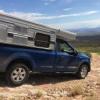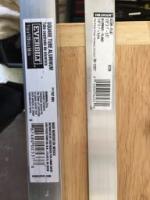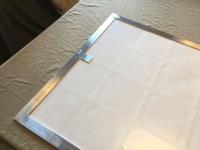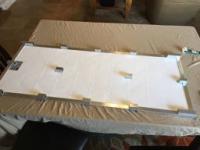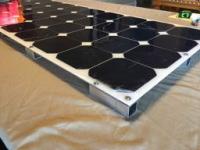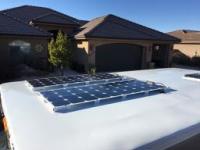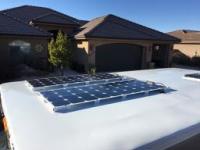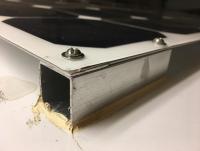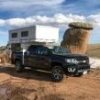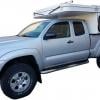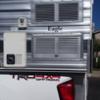About 8 months ago I installed flexible solar panels on the roof of my new 2016 Grandby. My mounting was a bit unique, so I thought I would post it. Thanks to all the others who have gone before in posting their issues with flexible panels. My installation was an attempt to solve some of the issues others have had.
Many have had issues with gluing the panels directly to the roof. It apparently can cause overheating and failure of the flexible panels, also possibly raising the temperature of the interior, and making it difficult to remove any failed panel.
My solution was to (1) reinforce the flexible panel with 1 inch by 1/20 inch aluminum strip attached to the panel along the edges with VHB tape. Then (2) screw or bolt the panel to small pieces of 1 inch by 1 inch by 1/20th inch square tubing. The tubing was, in turn, attached to the roof with VHB tape. The result is a 1 inch air gap between the panel and the roof, and the panel reinforced somewhat on the edges to prevent fluttering in the wind.
The flexible panel I choose was the Solar Cenergy 120 Watt panel purchased from SolarBlvd. (I think I paid $119 per panel - now listed at $149, but out of stock.) Here is the info listed on the back:
I wired the two in series, making the supposed maximum voltage of 45.6 volts. These are wired into a Victron 100/300 MPPT controller. The 100 means it can take up to 100 volts max input, and the 30 means it can output up to 30 amps.
Here are the aluminum stock I used to make the base, purchased at Home Depot and/or Loews.
I used VHB tape to attach the 1 x 1/20 aluminum strip to the edges of the back of the panel.
I cut the 1 inch square tubing into small pieces and lightly glued them with a drop of silicon caulk to the aluminum strips.
Then I turned the whole thing over and screwed the panel to the 1/1 supports with flat head sheet metal screws. (The first one I attached with little stainless steel bolts, but this was too tedious, and the sheet metal screws worked just as well.)
I then placed VHB tape on the bottoms of the 1x1 supports, and simply attached to the roof of the camper.
The panels as mounted have a very low profile to wind, are extremely lightweight, have a lot of air flow underneath, and are fairly cheap. In a subsequent post I will outline the performance of the system so far.


